Golden Triangle (Southeast Asia)
The Golden Triangle[1] is the name given to one of Asia's two principal areas of illicit opium production (with the other being the Golden Crescent). Its geographical limits are the area in which the borders of Myanmar, Thailand, and Laos meet at the confluence of the Ruak and the Mekong Rivers.[2][3] The name "Golden Triangle" was coined by the CIA[4] and is commonly used more broadly to refer to an area of approximately 950,000 square kilometres (367,000 sq mi) that overlaps the mountains of the four adjacent countries.
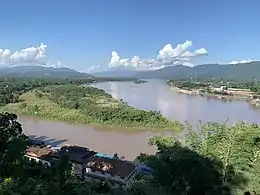 | |
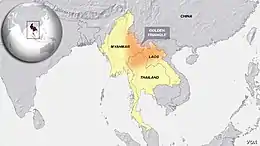 | |
| Continent | Southeast Asia |
|---|---|
| Region | Myanmar, Thailand, Laos |
| Coordinates | 20°21′20″N 100°04′53″E |
Along with Afghanistan in the Golden Crescent, it has been one of the largest opium-producing areas of the world since the 1950s. Most of the world's heroin came from the Golden Triangle until the early 21st century when Afghanistan became the world's largest producer.[5] The majority of the region's opium is now produced in Myanmar and, to a lesser extent, Laos.
Opium production in Myanmar is the world's second-largest source of opium after Afghanistan, producing some 25% of the world's opium, forming part of the Golden Triangle. While opium poppy cultivation in Myanmar had declined year-on-year since 2015, cultivation area increased by 33% totalling 40,100 hectares alongside an 88% increase in yield potential to 790 metric tonnes in 2022 according to latest data from the United Nations Office on Drugs and Crime (UNODC) Myanmar Opium Survey 2022[6] With that said, the United Nations Office on Drugs and Crime (UNODC) has also warned that opium production in Myanmar may rise again if the economic crunch brought on by COVID-19 and the country's 2021 military coup persists, with significant public health and security consequences for much of Asia.[7]
Origin
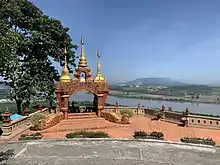
In the late 1940s, as the Chinese Communist Party gained power, it ordered ten million addicts into compulsory treatment, had dealers executed, and opium-producing regions planted with new crops. Consequently, opium production shifted south of the Chinese border into the Golden Triangle region.[8] Small-scale opium production in Myanmar dated back to the Konbaung dynasty in 1750, chiefly for the consumption of foreigners.[9]
The Chinese troops of the Kuomintang (KMT) in Burma were in effect the forebears of the private narcotic armies operating in the Golden Triangle. In 1949, thousands of the defeated Kuomintang troops crossed over the border from Yunnan Province into Burma, a nation with a weak government, and the Kuomintang seized control of the border regions of Burma. Almost all of the KMT opium was sent south to Thailand.[10]
The KMT-controlled territories made up Burma's major opium-producing region, and the shift in KMT policy allowed them to expand their control over the region's opium trade. Furthermore, Communist China's eradication of illicit opium cultivation in Yunnan by the early 1950s effectively handed the opium monopoly to the KMT army in the Shan State. The main consumers of the drug were the local ethnic Chinese and those across the border in Yunnan and the rest of Southeast Asia. They coerced the local villagers for recruits, food and money, and exacted a heavy tax on the opium farmers. That forced the farmers to increase their production to make ends meet. One American missionary to the Lahu tribesmen of Kengtung State testified that the KMT tortured the Lahu for failing to comply with their regulations.
Annual production increased 20 times, from 30 tons at the time of Burmese independence to 600 tons in the mid-1950s.[11]
History of heroin production


Myanmar is the world's second largest producer of illicit opium, after Afghanistan[5] and has been a significant cog in the transnational drug trade since World War II.[12] According to the UNODC it is estimated that in 2005 there wеrе 430 square kilometres (167 sq mi) of opium cultivation in Myanmar.[13]Opium and heroin base produced in northeastern Myanmar are transported by horse and donkey caravans to refineries along the Thailand–Burma border for conversion to heroin and heroin base. Most of the finished products are shipped across the border into various towns in North Thailand and down to Bangkok for further distribution to international markets.
The surrender of drug lord Khun Sa's Mong Tai Army in January 1996 was hailed by Yangon as a major counter-narcotics success. Lack of government will and ability to take on major narcotrafficking groups and lack of serious commitment against money laundering continues to hinder the overall anti-drug effort. Most of the tribespeople growing the opium poppy in Myanmar and in the Thai highlands are living below the poverty line.
In 1996, the United States Embassy in Rangoon released a "Country Commercial Guide", which states "Exports of opiates alone appear to be worth about as much as all legal exports." It goes on to say that investments in infrastructure and hotels are coming from major opiate-growing and opiate-exporting organizations and from those with close ties to these organizations.[14]
A four-year investigation concluded that Myanmar Oil and Gas Enterprise (MOGE) was "the main channel for laundering the revenues of heroin produced and exported under the control of the Myanmar Army." In a business deal signed with the French oil giant Total in 1992, and later joined by Unocal, MOGE received a payment of $15 million. "Despite the fact that MOGE has no assets besides the limited installments of its foreign partners and makes no profit, and that the Myanmar state never had the capacity to allocate any currency credit to MOGE, the Singapore bank accounts of this company have seen the transfer of hundreds of millions of US dollars," reports François Casanier. According to a confidential MOGE file reviewed by the investigators, funds exceeding $60 million and originating from Myanmar's most renowned drug lord, Khun Sa, were channeled through the company. "Drug money is irrigating every economic activity in Myanmar, and big foreign partners are also seen by the SLORC as big shields for money laundering."[14] Banks in Rangoon offered money laundering for a 40% commission.[15] A United Nations report also cites corruption, poverty and a lack of government control as typical causes for impoverished farmers to engage in drug production.[16]
Heroin processing in Southeast Asia
In 1992, the U.S. Department of Justice released a report[17] detailing the typical process in which raw opium extracted from poppy plants is converted to morphine and then to heroin:
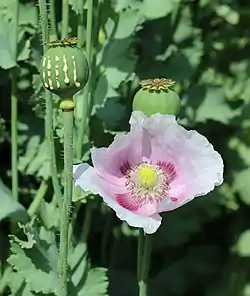
- an average Golden Triangle opium farmer will plant an area of half a hectare (which would produce an average of 50,000 poppy plants) towards the end of the traditional Rainy Season in September, which will allow harvesting to begin in February of the following year when the plant has matured. About two weeks after the flower petals fall from the now swollen pods, the farmer will use a tool with 3 or 4 blades to make one millimeter deep diagonal incisions in each pod. This is done usually in the afternoon so that the white latex-like raw opium can ooze out onto the surface of the pod overnight.
- the farmer then scrapes the secretion off each pod with a curved tool and places it into a container. This is repeated up to six times until the pod is depleted and stops leaking fluid. Each pod will yield an average of 80 milligrams of raw opium, with the half a hectare field producing an average of between 4 and 8 kilograms in total.
- the collected opium contains a high percentage of water, so the farmer will dry it in the hot sun for several days (as its value increases due to less water weight per kilogram) and then cut into standard sized 1.6 kilogram blocks and wrap in plastic ready for sale to opium traders.
- to convert the opium to morphine, approximately 15 kilograms of raw opium is added to 30 gallons of water in a 55 gallon metal oil drum. A fire is lit under the drum and the solution is brought to the boil. After the opium has dissolved, non-soluble materials (such as plant twigs) float to the top and are scooped out. Calcium hydroxide is then added to convert the water insoluble morphine into water soluble calcium morphenate, with any other alkaloids turning to sludge. After it has cooled, the contents are poured through a filter (like a burlap sack) into a pot and the collected filtered liquid is reheated to a simmer. Ammonium chloride is then added to adjust the pH level to 9, and the liquid is then left to cool for a couple of hours.The morphine base will gradually precipitate out of the solution and settle to the bottom of the pot. The liquid is then poured off through a filter and any chunks collected are added back into the pot. The remaining solids are then scrapped out and left to dry in the sun until they turn into a coffee-colored powder, and what is left at the end of this process is a crude morphine base. This is then dissolved in hydrochloric acid, then boiled and filtered several times before being pressed into 1.3 kilogram bricks, which are then transported down from the highlands to heroin-processing laboratories.
- the morphine hydrochloride bricks are broken up into powder and then placed in a pot with acetic anhydride. The pot is then heated to a simmer for approximately two hours, during which the morphine and the anhydride become chemically bonded, creating an impure form of diacetylmorphine (heroin). Water is then added, along with charcoal, and after stirring, the liquid is strained out through a filter into a new container. Sodium carbonate is dissolved in hot water and then added slowly, which causes the heroin base to precipitate to the bottom of the container. This is then filtered out and dried in a steam bath for an hour. For every 455 grams of morphine, approximately 311 grams of crude heroin base can be extracted. This is then sent to a heroin-refining laboratory.
- Heroin Number 3, which is low quality (under 40% pure) and is typically consumed locally by smoking, is created by mixing crude heroin base with hydrochloric acid, resulting in heroin hydrochloride. Adulterants such as caffeine or quinine are added in a one to one ratio, and the wet paste is stirred to dryness over a steam bath. The resulting dry heroin number 3 will be in the form of dark brown coarse lumps, which are transferred into 1 kilogram plastic bags and then sold onto wholesale traffickers.
- Heroin number 4, which is high quality (over 80% pure) and is typically exported for consumption by injecting, is created by mixing crude heroin base with water and acetic anhydride. After stirring, a small amount of chloroform is added. After 20 minutes or so, impurities will sink to the bottom of the pot and a red greasy layer will float to the top, and the light yellow water layer in the middle is carefully poured off into a clean container. Charcoal is stirred in, and the liquid is then poured out through a filter into a new, clean pot, and this process is repeated until the liquid becomes clear. Sodium carbonate is dissolved in hot water and then added slowly, which causes the heroin base to precipitate to the bottom of the container. This is filtered out and dried in a steam bath for an hour. The resulting, dry "heroin number 4" will be in the form of a very white, fine powder, which is then pressed into 350 gram blocks and wrapped in plastic.[18] These are then sold onto wholesale traffickers.
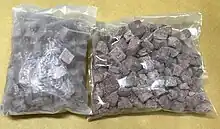
In the same year, the U.S. Department of Justice published a separate report [19] with estimated prices for Southeast Asian heroin at various stages from point of production to final street sale:
| Product | Location | Purity | Estimated Price |
|---|---|---|---|
| Raw Opium | Shan State | 100% | $120 to $200 per kilogram |
| Morphine Base | Thai - Burma border | 100% | $1,000 per kilogram |
| Heroin Base | Chang Mai | 100% | $3,520 to $4,400 per kilogram |
| Heroin | Chang Mai | 90% to 70% | $4,000 to $4,900 per kilogram |
| Heroin | Bangkok | 90% to 70% | $6,000 to $11,000 per kilogram |
| Heroin | U.S.A (wholesale) | 90% to 70% | $90,000 to $240,000 per kilogram |
| Heroin | U.S.A (mid level) | 80% to 30% | $100,000 to $600,000 per kilogram |
| Heroin | U.S.A (street level) | 60% to 20% | $100,000 to $1,000,000 per kilogram |
Historical drug trafficking
1970s
After hearing about African American soldiers serving in the Vietnam War becoming addicted to heroin while on R&R in Thailand, American drug lord Frank Lucas travelled to Bangkok in the early 1970s in an attempt to set up a new trafficking route with his associate Ike Atkinson. After Lucas visited the Golden Triangle region and made an initial purchase of 132 kilograms of uncut heroin (98–100% pure) from remnants of Chiang Kai-shek’s defeated Kuomintang army--for a price of $4,200 per kilogram compared to the $50,000 each that New York Mafia charged--Atkinson used his contacts within the US military to smuggle the narcotics via US Air Force planes back to the eastern United States. It was then collected, cut to 10% purity, repackaged and distributed on the streets of Harlem by dealers controlled by Lucas for a vast profit. This smuggling route operated up until the arrest of Frank Lucas by the Drug Enforcement Administration in January 1975.[20][21][22]
In 1972, traditional European supply routes for American-consumed heroin were disrupted after Turkey banned the growing of opium poppies, which led to an increase in production in South East Asia.[23] With an existing organised crime infrastructure to service a large local population of addicts, combined with its busy international seaport and airport, Hong Kong soon became an important transit point for Southeast Asian heroin,[24] as well as convenient money laundering center to reinvest the profits of international sales.[25][26]
In the mid 1970s, a group comprised mainly of Singaporean Chinese traffickers known as the Ah Kong took control of the European heroin trade by smuggling heroin using couriers via airplane from Thailand and Malaysia to their headquarters in Amsterdam, where it was then distributed to other major cities in western Europe.[27]So successful were the gang that they muscled in on and ultimately took over the European territory of the 14K and Wo Shing Wo groups of triads.[28]
Heroin from Southeast Asia was originally brought to the United States by couriers, typically Thai and U.S. nationals, travelling on commercial airlines. Despite its strict drug laws, Singapore was often used as a transit point, [29] as traffickers believed foreign law enforcement agencies would be less stringent in checking passengers on arrival if their flight departed from Singapore[30].California and Hawaii were the primary U.S. entry points for Golden Triangle heroin, but small percentages of the drug were also trafficked into New York City and Washington, D.C. While Southeast Asian groups had success in trafficking heroin to the United States, they initially had difficulty arranging street level distribution. However, with the incarceration of Asian traffickers in American prisons during the 1970s, contacts between Asian and American prisoners developed. These contacts have allowed Southeast Asian traffickers access to gangs and organizations distributing heroin at the retail level.[31]
1980s
In the 1980s, after traditional Italian American organized crime groups were substantially weakened by a series of major prosecutions, ethnic Chinese traffickers gradually took over the dominant role in the heroin supply on the American east coast. A Drug Enforcement Administration study identified the source of the heroin sold on the streets of New York: from 1982 to 1987, the percentage of Southeast Asian heroin rose from 3 percent to more than 40 percent of the market supply.[32]As demand grew, Asian criminal organizations began trafficking large shipments of high purity heroin hidden amongst legitimate seaborne cargo to the United States:
- the February 1988 seizure of 1,280 kilograms of 97% pure heroin hidden in bales of rubber sheets on a New York City bound freighter at Khlong Toei Port in Bangkok, with an estimated street price of $2 billion, [33] was the world’s largest single heroin seizure at the time.
- in February 1989, a U.S. record amount was seized when FBI agents in New York City raided a warehouse and discovered 380 kilograms of uncut heroin (with an estimated street price of $1 billion) hidden in lawn-mower tires, which authorities believed were shipped from Hong Kong to Los Angeles before being trucked to the New York area.[34]
- in early September 1989, the largest heroin seizure in the history of British Hong Kong occurred when narcotics agents raided an apartment in the Sai Kung district of the New Territories and discovered 420 kilograms of 99% pure heroin, worth an estimated $420 million, packed into 30 travel bags. The drugs were believed to have originated in Thailand before being smuggled by sea to Hong Kong, where they were then transferred to a local fishing junk and afterwards brought to shore via speedboat. Police believed the haul was ultimately destined for the United States or Australia[35][36]
- a new U.S. record was achieved in June 1991 when authorities seized 545 kilograms of high quality heroin (with an estimated street price of $3 billion) concealed in a shipment of plastic bags from a Californian warehouse. It was originally smuggled from Thailand to Taiwan, then placed aboard a ship and brought to the Port of Oakland.[37]
Efforts by East Asian traffickers to smuggle heroin via couriers on commercial airlines also continued, using methods such as strapping narcotics to the body and disguising under baggy clothing (such as Tong Ching Man) or hiding the drugs within secret compartments of luggage (like in the cases of Poon Yuen Chung and Angel Mou Pui Peng).
1990s
By the early 1990's, West African (primarily Nigerian) criminal organizations emerged as major traffickers of Southeast Asian heroin,[38] with 660 West Africans being arrested in the United States for heroin trafficking in the year 1991 alone. Instead of attempting to smuggle a single large shipment, Nigerian traffickers would typically recruit many low level non-Nigerian couriers (such as Johannes van Damme) to transport a couple of kilograms of heroin at a time via regular airline routes from transshipment points in Asia (such as Singapore)[39][40] to western Europe or the eastern United States. Once the heroin arrived at its final destination, it was transported to cutting and packaging mills where it was diluted and packaged for retail or street-level sale, with the profits then transferred to Lagos or Hong Kong for the purposes of money laundering.[41]In October 1996, U.S. law enforcement officials arrested members of a Chicago based Nigerian trafficking group that smuggled heroin from Thailand via couriers for distribution to cities across the American Midwest, that was believed to have supplied over 200 kilograms (with an estimated retail price of $100 million) a year to various street gangs in the region.[42]
Present day drug trafficking
Poppy cultivation in the country decreased more than 80 percent from 1998 to 2006 following an eradication campaign in the Golden Triangle. Officials with the United Nations Office of Drugs and Crime have confirmed that opium poppy farming has decreased since 2014, as synthetic drug production has expanded. The Golden Triangle is now one of the world's leading areas for the production of synthetic drugs and particularly methamphetamine as production has scaled up of Yaba tablets and crystalline methamphetamine, including for export to Australia, New Zealand, and across East and Southeast Asia.[43] With respect to the accelerating synthetic drug production in the region, and specifically in Shan State, Myanmar, Sam Gor, also known as "The Company", is understood to be one of the main international crime syndicates responsible for this shift.[44] Made up of members of five different triads and understood to be headed by Tse Chi Lop, a Canadian gangster born in Guangzhou, China, the Cantonese Chinese syndicate is primarily involved in drug trafficking, potentially earning up to $8 billion per year.[45] Sam Gor is alleged to control 40% of the Asia-Pacific methamphetamine market, while also trafficking heroin and ketamine. The organization is active in a variety of countries in addition to Myanmar, including Thailand, Lao PDR, New Zealand, Australia, Japan, China and Taiwan.[46]
The Chinese Muslim Panthay are the same ethnic group as the Muslims among the Chinese Chin Haw.[47] Both are descendants of Chinese Hui Muslim immigrants from Yunnan province in China. They often work with each other in the Golden Triangle Drug Trade. Both Chinese Muslim and non-Muslim Jeen Haw and Panthay are known to be members of Triad secret societies, working with other Chinese groups in Thailand like the TeoChiew and Hakka and the 14K Triad. They engaged in the heroin trade. Ma Hseuh-fu, from Yunnan province, was one of the most prominent Jeen Haw heroin drug lords.
A Panthay from Burma, Ma Zhengwen, assisted the Han Chinese drug lord Khun Sa in selling his heroin in north Thailand.[48]: 306 The Panthay monopolized opium trafficking in Burma.[48]: 57 They also created secret drug routes to reach the international market with contacts to smuggle drugs from Burma via south China.[48]: 400
Methamphetamine production and trafficking
"The Golden Triangle, and specifically Shan State of Myanmar, is believed to be the largest methamphetamine producing area in the world (modest sized geographic area with highly concentrated production)." The growing signs of an intensification of methamphetamine manufacturing activity within and around the Golden Triangle, and a corresponding decrease in the number of production facilities dismantled in other parts of the region, suggests that methamphetamine manufacture in East and Southeast Asia is now consolidated into the lower Mekong region.[49] Countries in East and Southeast Asia have collectively witnessed sustained increases in seizures of methamphetamine over the last decade, totalling over 171 tons and a record of over 1 billion methamphetamine tablets in 2021 according to the United Nations Office on Drugs and Crime, more than any other part of the world.[50] In April and May 2020, Myanmar authorities reported Asia's largest ever drug operation in Shan State totalling what was believed to be 193 million methamphetamine tablets, hundreds of kilogrammes of crystal methamphetamine as well as some heroin, and over 162,000 litres and 35.5 tons of drug precursors as well as sophisticated production equipment and several staging and storage facilities.[51]
References
- (Burmese: ရွှေတြိဂံ နယ်မြေ, pronounced [ʃwè tɹḭɡàɰ̃ nɛ̀mjè]; Thai: สามเหลี่ยมทองคำ, RTGS: sam liam thong kham, pronounced [sǎːm.lìa̯m tʰɔ̄ːŋ kʰām]; Lao: ສາມຫຼ່ຽມທອງຄຳ; Chinese: 金三角, Vietnamese: Tam giác Vàng, Khmer: តំបន់ត្រីកោណមាស, pronounced [tɑmbɑn trəy kaon mieh])
- Sen, S (July–September 1991). "Heroin Trafficking in the Golden Triangle". Police Journal. 64 (3): 241. Retrieved 19 June 2023.
- "GOLDEN TRIANGLE". Tourism Authority of Thailand (TAT). Archived from the original on 31 July 2019. Retrieved 4 April 2018.
- O'Riordain, Aoife (22 February 2014). "Travellers Guide: The Golden Triangle". The Independent. Retrieved 4 April 2018.
- "Afghanistan Again Tops List of Illegal Drug Producers" Archived 6 January 2017 at the Wayback Machine. The Washington Times Archived 6 January 2017 at the Wayback Machine. 12 March 2013.
- "Myanmar Opium Survey 2021: Cultivation, Production and Implications". February 2022.
- "Myanmar's Economic Meltdown Likely to Push Opium Output Up, Says UN". 31 May 2021. Retrieved 15 October 2021.
- Alfred W. McCoy. "Opium History, 1858 to 1940". Archived from the original on 4 April 2007. Retrieved 4 May 2007.
- James, H. (2012). Security and Sustainable Development in Myanmar/Burma. Routledge. pp. 94–. ISBN 9781134253937.
- McCoy, Alfred W. (1991). The Politics of Heroin: CIA Complicity in the Global Drug Trade (1st ed.). Brooklyn, N.Y.: Lawrence Hill Books. p. 173. ISBN 9781556521263.
- Lintner, Bertil (1992). Heroin and Highland Insurgency in the Golden Triangle. War on Drugs: Studies in the failure of US narcotic policy. Boulder, Colorado: Westview. p. 288.
- Gluckman, Ron. "Where has all the opium gone?". Ron Gluckman.
- "Facts and figures showing the reduction of opium cultivation and production..." Archived 14 March 2012 at the Wayback Machine. Embassy of the Union of Myanmar in Pretoria Archived 6 March 2009 at the Wayback Machine. 23 October 2005.
- Bernstein, Dennis; Leslie Kean (16 December 1996). "People of the Opiate: Myanmar's dictatorship of drugs". The Nation. 263 (20): 11–15. Archived from the original on 1 June 2004. Retrieved 6 July 2008.
- Alexander Cockburn; Jeffrey St. Clair (1998). Whiteout: The CIA, Drugs and the Press. London: Verso. p. 230. ISBN 1-85984-139-2.
whiteout cockburn.
- (February 2020). "Myanmar Opium Survey: cultivation, production and implications". UNODC.
- "Opium Poppy Cultivation and Heroin Processing in Southeast Asia" (PDF). U.S. Department of Justice. 1 September 1992.
- "AFP seizes 336 kilograms of heroin in largest ever Queensland detection". Australian Federal Police press release. 4 April 2023.
- "Worldwide Heroin Situation 1991" (PDF). U.S. Department of Justice. 1 January 1992.
- "The Return of Superfly". New York. 14 August 2000. Archived from the original on 25 May 2006. Retrieved 16 March 2023.
- "Is 'American Gangster' really all that 'true'?". CNN. 22 January 2008. Archived from the original on 3 March 2008. Retrieved 24 February 2008.
- Jacobson, Mark (25 October 2007). "A Conversation Between Frank Lucas and Nicky Barnes – Money 2007 – New York Magazine". New York. Retrieved 2 July 2011.
- "The heroin smugglers will have to go East". The Straits Times. 15 July 1971.
- "New blitz on drugs". New Nation. 23 March 1976.
- "Hong Kong underworld moving to America". Singapore Monitor. 3 February 1985.
- "Hongkong the centre of S-E Asia drug traffic". The Strait Times. 28 January 1983.
- "How CNB helped to crack world drug ring". The Straits Times. 10 April 1982.
- "WORLD DRUG RING CRACKED". The Straits Times. 11 September 1978.
- "Anti-drug bureau scores successes". The Straits Times. 12 May 1986.
- "Drug couriers try to cash in on tough laws". The Straits Times. 6 March 1989.
- "Chapter III Part 1: Drug Trafficking and Organized Crime". America's Habit. Schaffer Library of Drug Policy. 1986.
- "CHINESE NOW DOMINATE NEW YORK HEROIN TRADE". The New York Times. 9 August 1987.
- "The World". The Los Angeles Times. 14 February 1988.
- "Asian Drug Ring Crushed in N.Y. Record Cache of 838 Pounds of Heroin Is Seized". The Los Angeles Times. 22 February 1989.
- "Hongkong police seize $820m worth of heroin". The Straight Times. 6 September 1989.
- "Hong Kong police make huge heroin bust". UPI. 5 September 1989.
- "Largest Heroin Bust in U.S. Is Reported, Drugs About 1,200 pounds are seized at Hayward warehouse. Four suspects are arrested". The Los Angeles Times. 21 June 1991.
- "Out of Africa: The drug trail". The Strait Times. 29 April 1991.
- "Foiled: Nigerian's plan to use S'pore as base to recruit drug couriers". The Straits Times. 13 October 1991.
- "Drug couriers try to cash in on tough laws". The Straits Times. 6 March 1989.
- "Worldwide Heroin Situation 1991" (PDF). U.S. Department of Justice. 1 January 1992.
- "MAJOR DRUG NETWORK BROKEN, OFFICIALS SAY". The Washington Post. 12 October 1996.
- "Transnational Organized Crime in Southeast Asia: Evolution, Growth and Challenges". June 2019.
- "The Man Accused of Running the Biggest Drug Trafficking Syndicate in Asia's History has Been Revealed: Here's What Needs To Happen Next". 24 October 2019.
- Smith, Nicola (14 October 2019). "Drugs investigators close in on Asian 'El Chapo' at centre of vast meth ring". The Telegraph. London.
- Douglas, Jeremy (15 November 2018). "Parts of Asia are slipping into the hands of organized crime". CNN.
- Forbes, Andrew ; Henley, David (2011). Traders of the Golden Triangle. Chiang Mai: Cognoscenti Books. ASIN: B006GMID5K
- Bertil Lintner (1999). Burma in Revolt: Opium and Insurgency Since 1948. Chiang Mai: Silkworm Books. p. 306. ISBN 974-7100-78-9. Retrieved 12 April 2011.
Li's rival Khun Sa was connected with other networks. Heroin, which had been refined in laboratories under Khun Sa's control, was marketed in northern Thailand by Ma Zhengwen, a Yunnanese Muslim (Panthay) born in Burma.
- Douglas, Jeremy (15 November 2018). "Parts of Asia are slipping into the hands of organized crime". CNN.
- "Synthetic Drugs in East and Southeast Asia: Latest Developments and Challenges 2022". May 2022.
- "Huge fentanyl haul seized in Asia's biggest-ever drugs bust". Reuters. 18 May 2020 – via www.reuters.com.
External links
 Golden Triangle (Southeast Asia) travel guide from Wikivoyage
Golden Triangle (Southeast Asia) travel guide from Wikivoyage Media related to Mekong Golden Triangle at Wikimedia Commons
Media related to Mekong Golden Triangle at Wikimedia Commons- Geopium: Geopolitics of Illicit Drugs in Asia. Geopium.org (since 1998) is the personal website of Pierre-Arnaud Chouvy, CNRS Research Fellow in Paris.
- Kramer, Tom, Martin Jelsma, and Tom Blickman. Withdrawal Symptoms in the Golden Triangle: A Drugs Market in Disarray. Amsterdam: Transnational Institute, January 2009. ISBN 978-90-71007-22-4.
- "The Golden Triangle Opium Trade: An Overview" by Bertil Lintner, Chiang Mai, March 2000
- UNODC. "Transnational Organized Crime in Southeast Asia: Evolution, Growth and Impact". UNODC Regional Office for Southeast Asia and the Pacific, June 2019.